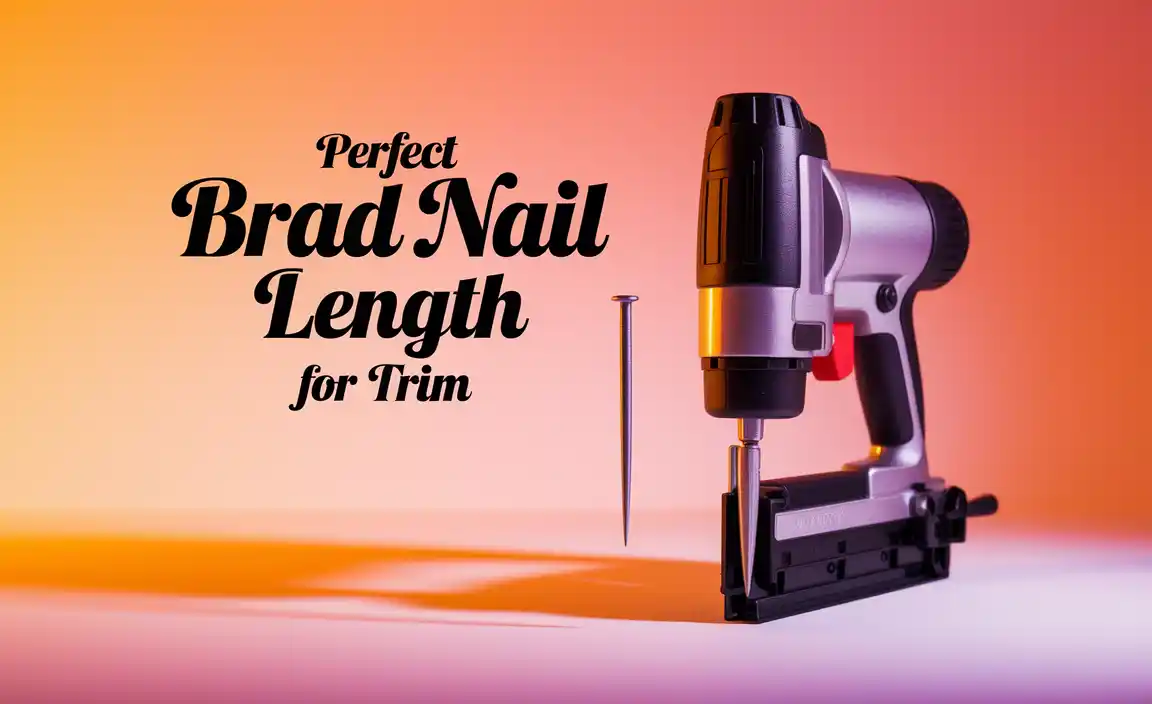To use a narrow crown stapler effectively, learn about its specific applications, select the right staples, adjust depth settings, and practice safe, consistent fastening for secure woodworking projects. This guide breaks down everything you need to know for successful results.
Hey there, DIYer! Ever found yourself wrestling with a project, needing to attach thin trim or delicate molding, and wishing for a tool that could do it cleanly and securely? That’s where the humble narrow crown stapler shines. It’s a fantastic tool for those finer woodworking tasks where a larger staple or nail would be overkill and potentially unsightly. But like any tool, knowing how to wield it makes all the difference between a professional finish and a frustrating mess. Don’t worry; we’re going to walk through it all, step-by-step, so you can tackle your trim work, upholstery, and other delicate jobs with confidence. You’ll be amazed at how simple it is once you know the secrets!
Table of Contents
What is a Narrow Crown Stapler and Why You Need One
A narrow crown stapler is a specialized pneumatic or electric tool designed to drive narrow staples into wood and other materials. Think of it as a precision instrument for fastening. Unlike wider staplers often used for construction framing, the narrow crown stapler is built for delicate work. Its staples have a thin wire and a narrow crown (the top part that sits on the surface), which means they leave a smaller, less noticeable mark. This makes them ideal for:
Attaching trim and molding: Getting those clean lines on baseboards, casing, and decorative trim without splitting the wood.
Upholstery: Securing fabric to furniture frames.
Cabinetry: Holding smaller parts or decorative elements in place during assembly.
Screen repair: Reattaching window or door screens.
Craft projects: For various intricate building tasks.
The beauty of a narrow crown stapler is its ability to provide a strong hold with minimal damage to the material. This detail-oriented fastening capability is what makes it an indispensable tool for many DIYers and professionals alike.
Narrow Crown Staples vs. Other Fasteners
It’s helpful to understand how narrow crown staples fit into the fastening family:
Brad Nails: Thinner than finishing nails, brad nails are good for delicate trim but can still leave a visible hole. They are fired from brad nailers.
Finishing Nails: Thicker than brad nails and can leave noticeable holes, often requiring filling.
Standard Staples: Much wider and more robust, used for heavier-duty applications but too intrusive for fine woodworking.
Narrow Crown Staples: The smallest and least intrusive option for many woodworking and upholstery tasks. They offer a good balance of holding power and a discreet appearance.
Key Components of a Narrow Crown Stapler
Most narrow crown staplers, whether electric, pneumatic, or battery-powered, share common components:
Magazine: Holds the strip of staples.
Nose/Tip: Where the staple is driven into the material.
Trigger: fires the staple.
Air Inlet (for pneumatic): Where you connect the air hose.
Power Cord/Battery (for electric/battery): The power source.
Depth Adjustment Wheel/Dial: Controls how deep the staple is driven.
Safety Tip/Contact Nose: A safety mechanism that prevents firing unless pressed against a surface.
Choosing the Right Narrow Crown Staples
Selecting the correct staples is crucial for the performance of your narrow crown stapler. Staples are typically identified by their leg length and crown width. For a narrow crown stapler, you’ll be looking for staples with a narrow crown, usually around 1/4 inch (or 6mm).
Understanding Staple Specifications
Staple packaging will usually have dimensions like “18 gauge, 1-1/4 inch x 1/4 inch.” Let’s break that down:
Gauge: Refers to the thickness of the staple wire. Common gauges for narrow crown staplers are 18 gauge (thinner, for delicate work) or sometimes 16 gauge (slightly thicker, for a bit more hold).
Length: The total length of the staple’s leg (e.g., 1 inch, 1-1/4 inch). Choose a length that penetrates the material you’re fastening securely but doesn’t go all the way through.
Crown Width: This is your “narrow crown.” Standard narrow crowns are often around 1/4 inch (or 6mm).
Match Staples to Your Stapler
Always consult your stapler’s manual to determine the exact size and gauge of staples it’s designed to use. Using the wrong staples can cause jams, damage the tool, or result in poor fastening.
Types of Narrow Crown Staples
Galvanized Staples: Offer rust resistance, ideal for projects that might be exposed to moisture.
Stainless Steel Staples: Provide superior corrosion resistance for outdoor projects.
Coated Staples: Some staples have a light coating to reduce friction and improve drive.
Getting Started: Essential Preparations
Before you fire a single staple, a little preparation goes a long way to ensure safety and success.
Gather Your Tools and Materials
Narrow Crown Stapler: Ensure it’s the correct type for your task (pneumatic, electric, battery).
Appropriate Narrow Crown Staples: As discussed above.
Air Compressor & Hose (if pneumatic): Make sure the compressor is adequate for your stapler’s needs and the hose is in good condition.
Power Source (if electric/battery): Fully charged battery or a power outlet and extension cord.
Safety Gear:
Safety Glasses: This is non-negotiable. Staples can ricochet.
Hearing Protection: Especially important for pneumatic staplers.
Work Gloves: To protect your hands.
Your Project Materials: The wood, fabric, or other material you’re working with.
Workspace: A stable and well-lit area.
Setting Up Your Narrow Crown Stapler
1. For Pneumatic Staplers:
Connect the air hose securely to the stapler’s air inlet and your compressor.
Set your compressor’s regulator to the recommended operating pressure for your stapler. This is usually found in the stapler’s manual and is often between 70-100 PSI. Never exceed the maximum recommended pressure.
2. For Electric/Battery Staplers:
Ensure the battery is fully charged and properly inserted, or plug the tool into a power source.
3. Loading the Staples:
Locate the staple magazine on your stapler.
Press the release mechanism (usually a button or lever) to pull the magazine open.
Insert a strip of the correct narrow crown staples into the magazine, ensuring they are seated correctly against the driver blade.
Close the magazine firmly until it latches.
Crucially, test fire the stapler off your workpiece in a safe direction (away from people and yourself) to ensure the staples are feeding correctly. You may need to depress the safety tip and trigger.
Safety First!
Always wear safety glasses. This is the most critical safety rule.
Never point the stapler at yourself or anyone else. The safety tip must be depressed for the tool to fire.
Keep your fingers away from the nose of the stapler.
Disconnect power (air or electricity) before loading/unloading staples, making adjustments, or clearing jams.
Ensure the tool isn’t accidentally triggered. For pneumatic tools, disconnect the air hose. For electric/battery tools, remove the battery or unplug.
Read your tool’s manual. Every stapler has specific operating and safety instructions. You can find many manuals online from manufacturers like DEWALT or Milwaukee Tool.
How to Use a Narrow Crown Stapler: Step-by-Step
Now that you’re prepped and geared up, let’s get to the actual stapling. It’s simpler than you might think!
Step 1: Adjust the Depth Setting
This is one of the most important settings for a clean finish. You want the staple to be driven just below the surface of your material, or flush, without damaging the wood or coming out the back.
Find the Depth Adjustment: This is usually a wheel or dial located near the nose of the stapler.
Test on Scrap Material: Grab a piece of scrap wood identical to what you’re working with.
Start with a Medium Setting: Set the adjustment to a middle setting.
Fire a Staple: Press the safety tip firmly against the scrap wood and pull the trigger.
Inspect the Staple:
Too Deep: If the staple is sunk too far into the wood, making a large hole or even splitting it, reduce the depth setting (turn the dial counter-clockwise, or in the direction that makes it less aggressive).
Too Shallow: If the staple is sitting proud on the surface, leaving a noticeable bump, increase the depth setting (turn the dial clockwise, or in the direction that makes it more aggressive).
Repeat: Continue adjusting and testing until you achieve the desired depth for a clean, secure set on every staple.
Step 2: Position the Stapler and Material
Workpiece Stability: Ensure the piece you’re stapling into is stable. If it’s a small trim piece, clamp it securely to your workbench.
Stapler Placement: Place the nose of the stapler firmly against the surface where you want to drive the staple. The safety tip must be pressed against the material for the stapler to fire.
Staple Location: Aim to place staples where they will be least visible or where they provide the most structural support without compromising the look. For trim, this often means placing them along the edge or into a thicker substrate behind the trim.
Step 3: Drive the Staples
Firm Pressure: Apply steady, firm pressure with the stapler’s nose against the material. This activates the safety mechanism and ensures proper staple drive.
Pull the Trigger: Squeeze the trigger smoothly to drive the staple.
Hold for a Moment: After firing, keep slight pressure on the tool for a split second. Some tools benefit from this to ensure the staple is fully seated.
Release and Reposition: Lift the stapler away and reposition it for the next staple. For consistent spacing, you can use a tape measure or simply eyeball it, depending on the project’s requirements.
Step 4: Continuous Stapling
Continue this process of positioning, pressing, and firing to complete your fastening task.
Watch Your Staple Count: Be aware of how many staples are left in the magazine. Most staplers will not fire when empty, but it’s good to anticipate.
Step 5: Clearing Jams (If They Happen)
Even with proper use, jams can occur. Don’t panic!
1. Disconnect Power: Immediately disconnect the air hose or remove the battery/unplug the tool. This is the first and most important step.
2. Locate the Jam: Look at the nose of the stapler to see if a staple is misfed.
3. Open the Magazine: Release the magazine and open it.
4. Carefully Remove Obstructions: Use needle-nose pliers or tweezers to gently pull out any bent or jammed staples. Avoid forcing anything, as you could damage the tool. Sometimes you might need to access an internal driver blade – consult your manual for how to safely do this.
5. Test Fire: Once the jam is cleared, reassemble the stapler, reconnect power, and test fire on scrap material to ensure it’s working correctly before returning to your project.
Pro Tips for Using Your Narrow Crown Stapler
Consider Sequential vs. Contact Fire: Many staplers offer a choice between sequential fire (trigger pull to fire) and contact fire (depress safety tip, then trigger for continuous bursts or rapid firing). For precision work and safety, sequential fire is often preferred for beginners and delicate trim. Contact fire can speed up upholstery work but requires more control.
Angle Your Staples: For extra holding power on thin materials, try angling your staples slightly into the adjoining piece of wood.
Pre-Drill for Hardwoods: If you’re working with very dense hardwoods, consider pre-drilling a small pilot hole to prevent splitting, especially near edges. You might also need to increase staple leg length or use a higher gauge staple if appropriate.
Watch for Oiling (Pneumatic): Pneumatic tools often require a few drops of specialized pneumatic tool oil in the air inlet weekly or as recommended by the manufacturer to keep them running smoothly.
Staple into Solid Substrate: When attaching trim, aim to have the staples penetrate into the wall stud or a solid backing material for maximum hold.
Clean Regularly: Dust and wood debris can build up. Wipe down your stapler regularly and keep the magazine area clean.
When a Narrow Crown Stapler is Your Best Choice
Here’s a quick rundown of scenarios where this tool truly shines:
| Project Type | Why a Narrow Crown Stapler is Ideal |
| :—————————- | :———————————————————————- |
| Attaching Picture Frame | Small, discrete fasteners that don’t distract from the artwork. |
| Installing Crown Molding | Thin staples provide grip without splitting delicate molding pieces. |
| Upholstery Work | Secures fabric tightly without creating large, visible holes. |
| Cabinet Door Trim | Allows for fine detail work on smaller cabinet components. |
| Attaching Thin Wood Veneer| Holds veneer in place without damaging its delicate surface. |
| DIY Crafts & Models | For intricate joinery where precision is key. |
| Screen Repair | Attaches mesh securely to frames with minimal impact. |
Limitations to Consider
While incredibly useful, a narrow crown stapler isn’t for every job:
Heavy Construction: It lacks the power for framing, sheathing, or subflooring.
Structural Load Bearing: The holding power of narrow staples is generally not sufficient for joints that bear significant weight or stress.
Very Thick Materials: If you need to drive fasteners more than an inch or so deep, you’ll need a different tool.
Troubleshooting Common Issues
| Problem | Possible Cause(s) | Solution(s) |
| :—————————— | :——————————————————————- | :——————————————————————————————————————————————————————————- |
| Staples Not Firing | 1. No power (air or battery). 2. Safety tip not depressed. 3. Jam. | 1. Check air hose connection and compressor pressure; ensure battery is charged or tool is plugged in. 2. Press the nose firmly against the work surface. 3. Clear any jams. |
| Staples Jamming | 1. Wrong staple size/gauge. 2. Frayed or bent staples. 3. Internal issue. | 1. Use only the specified staple size and gauge. 2. Inspect staple strips before loading; try a new strip. 3. Clean the tool; check for debris; consult the manual or service center. |
| Staples Not Driving Fully | 1. Insufficient air pressure (pneumatic). 2. Depth setting too shallow. | 1. Increase compressor pressure to recommended PSI. 2. Adjust depth setting to drive deeper. |
| Staples Driving Too Deep | 1. Depth setting too deep. | 1. Reduce the depth setting. |
| Tool Leaking Air (Pneumatic)| 1. Loose hose connection. 2. Worn O-rings or seals. | 1. Ensure hose is securely connected. 2. Inspect for damage; may require Seal replacement or professional servicing. |
—
Frequently Asked Questions (FAQ)
Q1: What is the main difference between a narrow crown stapler and a standard stapler?
A: The main difference is their intended use and staple size. A narrow crown stapler uses thin staples with a narrow crown (typically 1/4 inch) for delicate woodworking, trim, and upholstery. A standard desk stapler uses much larger, thicker staples and is designed for paper. It’s important not to confuse a narrow crown stapler with a wide crown stapler used in construction.
Q2: Can I use any type of staple in my narrow crown stapler?
A: No, absolutely not. You must use the specific gauge and size of narrow crown staples recommended by your stapler’s manufacturer. Using the wrong staples will cause jams, damage the tool, and result in poor performance. Always check your tool’s manual.
Q3: How do I adjust the depth of the staple when using a narrow crown stapler?
A: Most narrow crown staplers have a depth adjustment wheel or dial, usually located near the nose of the tool. You adjust this setting by turning it clockwise to drive staples deeper or counter-clockwise to drive them shallower. Always test your setting on a scrap piece of material first.
Q4: Is a narrow crown stapler suitable for attaching baseboards?
A: Yes, a narrow crown stapler is an excellent tool for attaching baseboards and other trim. Its small staples provide decent holding power without causing significant damage or leaving large holes that require a lot




